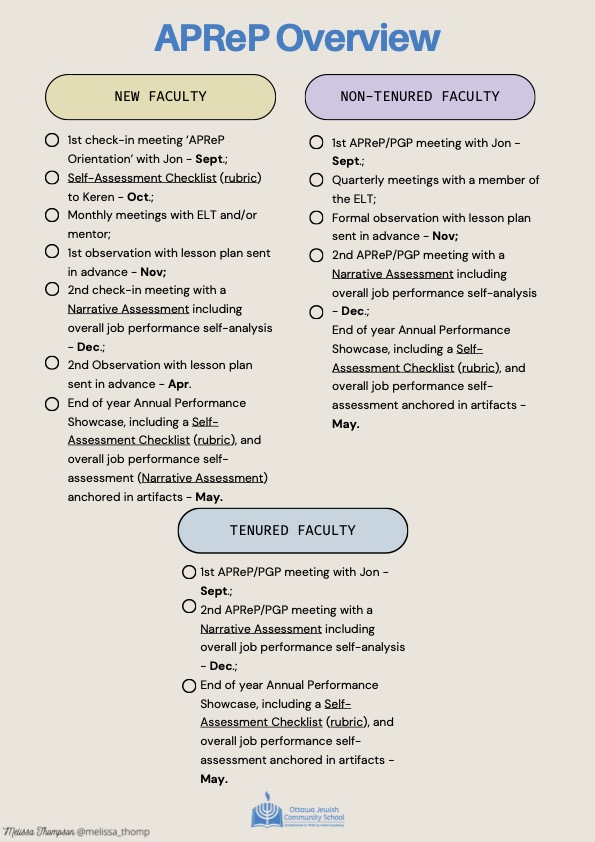When you have been doing this as long as I (somehow) have been doing this, it is natural to wind up with some sayings and “-isms” that help explain your “why” and core beliefs. Here is one of mine: “We should treat our teachers at least as well as we do our students”. There are lots of ways that can apply, but here I want to take a peek behind the curtain and share how we think about the critical work of growing our teachers. There are three OJCS North Stars that we aspire to for our students that apply at least as well to our teachers: 1) We own our learning, 2) We learn better together, and 3) There is a floor, but no ceiling.
Just as we want our students to take responsibility for their own learning as they develop in school, we empower our teachers to take ownership of their professional growth. The administration are not detectives looking to catch our teachers making mistakes, but partners in helping teachers become their best selves. Just as we know that learning is not done best alone, we encourage our teachers to grow themselves in cohorts, in community and in partnerships. And just as no two students are the same, we do not offer our teachers cookie-cutter PD; rather, we work with our teachers to co-create differentiated and personalized growth opportunities that meet them where they are and take them the next steps forward. [This does not mean that the administration never proscribes or requires particular growth experiences if that is what is called for; but we do try to start with the teacher’s passions and preferences.]
If you look up you will see our school’s Learning Target, which I have blogged about in the past. A quick reminder that,
This “Learning Target” is the instrument of alignment – meaning we can now make big and small decisions based on whether they bring our school closer to the target or not. If our “North Stars” represent unchanging aspirational endpoints of our educational journey, our “Learning Target” functions as a map and a compass.
Our teachers measure themselves – and we measure them – against a detailed rubric that describes varying degrees of excellence across these five domains and seventeen sub-domains. Each year we expect our teachers to demonstrate growth in (at least) one category. That season starts now. I am currently meeting with each teacher in our school to decide on a Professional Growth Project (PGP) that is intended to formally move that growth forward. Once I meet with each teacher and determine their PGP, they are shared with the full administration so we can build a calendar of professional growth opportunities aligned with this year’s needs.
If you are an OJCS Parent and not interested in more detail, feel free to skip the next section…

Because this blog does attract a broader audience than current families at OJCS (sorry if that reads like a bit of a humblebrag), I am going to tack on a few more technical pieces of the hows and whats of what we call our Annual Performance Review Process or APReP…
For transparency sake, here is the same graphic we provide our teachers as an overview:

Things to know…
…anyone in the field who would like samples of all the documents that are (not) hyperlinked in the above JPEG, just put your email address in a comment or email me directly (j.mitzmacher@theojcs.ca) and it will be my pleasure.
…this has been an iterative process over the years. We have added features, taken away features, etc. We currently distinguish between first-year teachers at OJCS, non-tenured teachers at OJCS, and tenured teachers at OJCS. [For my non-union friends, at our school, teachers become tenured if they are asked back for their fourth consecutive year of service.]
…”ELT” is our Educational Leadership Team.
…first-year teachers do not have a PGP as it is enough to acclimate yourself to a new school.
…new this year, veteran teachers may volunteer to sit on committees in lieu of PGPs upon request and agreeance from the administration.
…the APReP process is how we determine who our teachers are each year and which portfolios they are given. It is not intended to be a high-pressure or high-stakes process, but it does lead to meaningful outcomes. It is rigourous and it is serious.

Our teachers are our most important variable in school success. The more skilled, able, prepared and motivated our teachers…the greater the odds for all the outcomes we aspire towards. We are looking forward to great year of learning at OJCS this year…not just for our students, but for our teachers as well!


